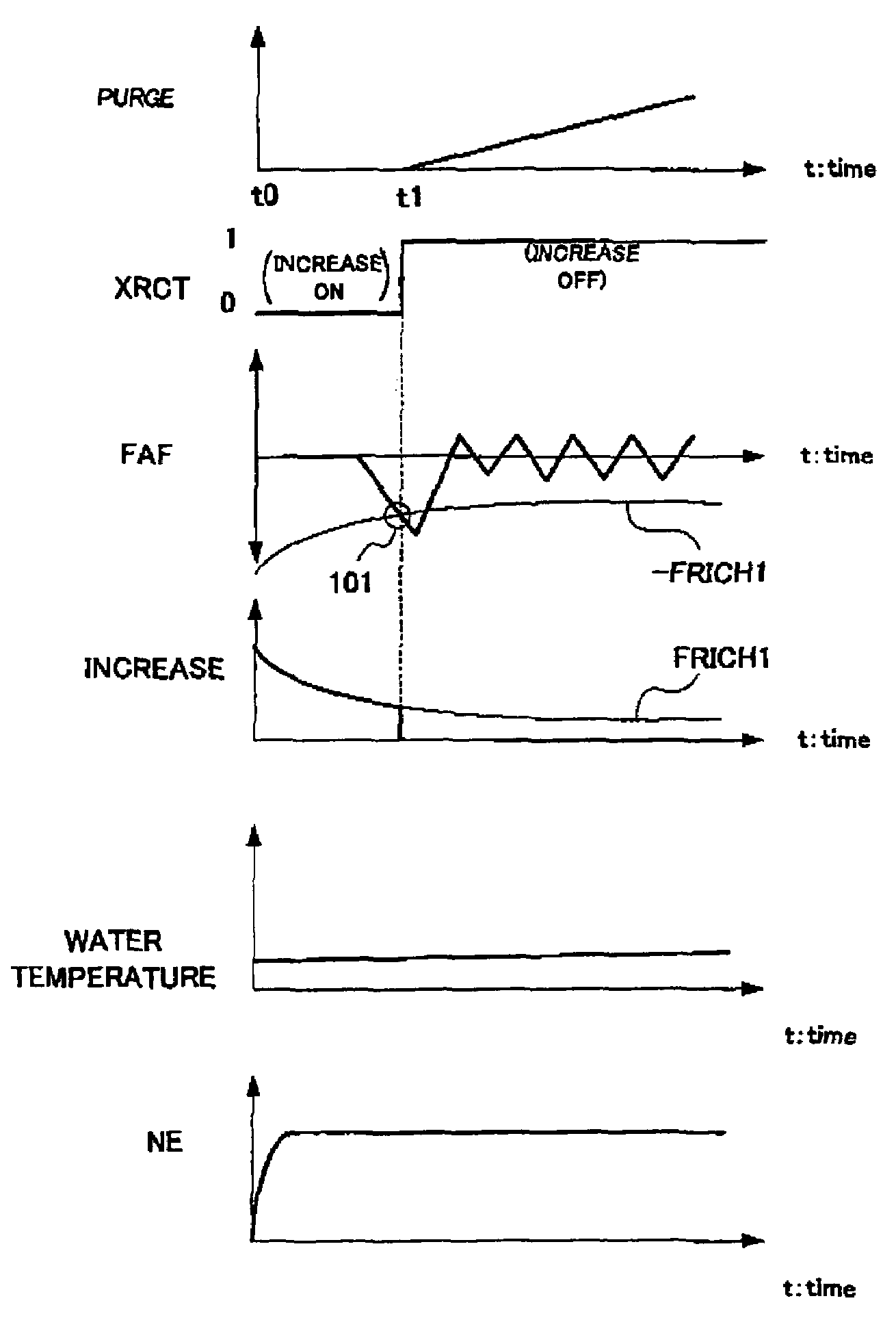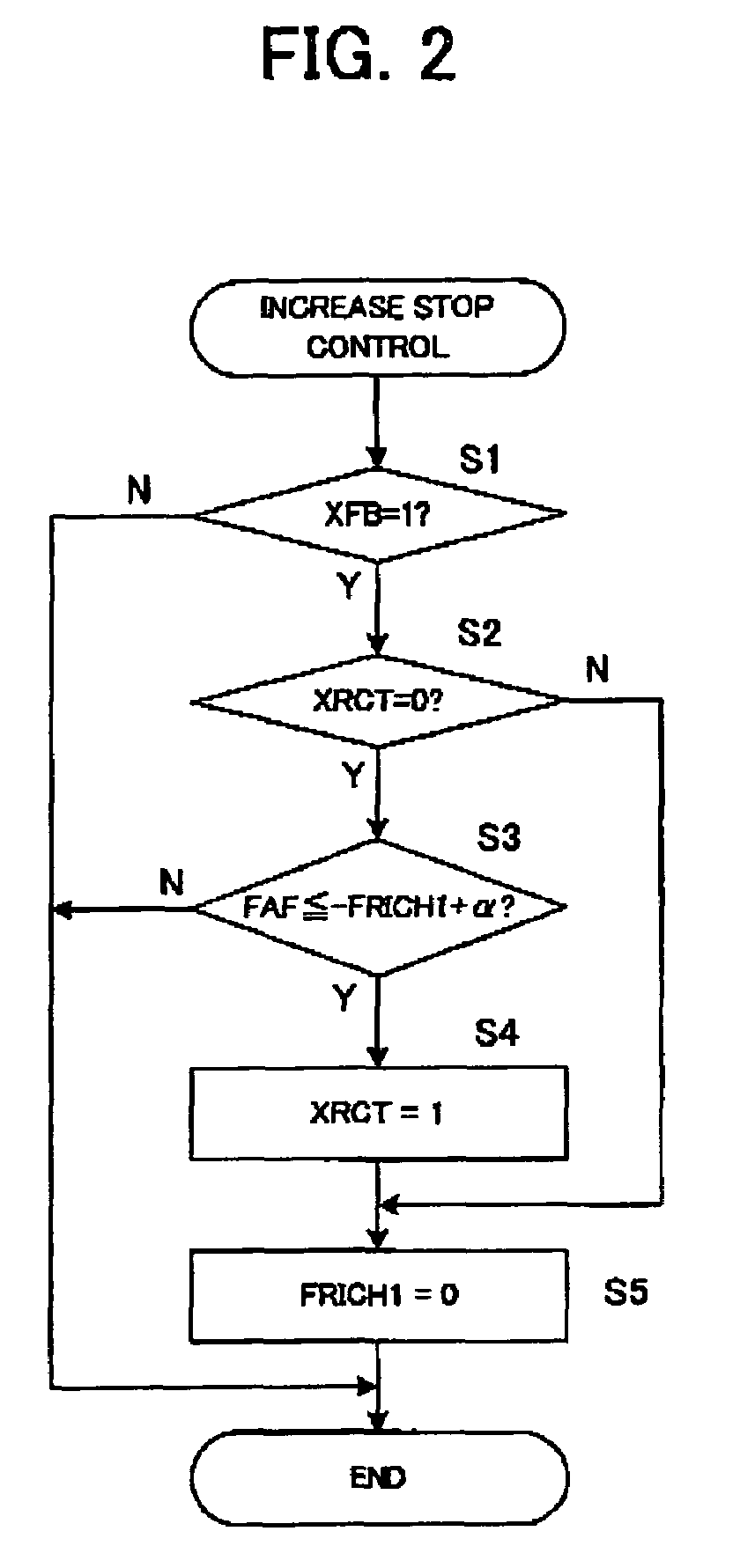Control apparatus for internal combustion engine
a control apparatus and internal combustion engine technology, applied in the direction of electric control, combustion-air/fuel-air treatment, instruments, etc., can solve the problems of reduced learning precision of vapor concentration, difficult to determine, and reduced air/fuel ratio change, so as to prevent useless fuel consumption and efficiently perform the effect of increasing the amount of fuel
- Summary
- Abstract
- Description
- Claims
- Application Information
AI Technical Summary
Benefits of technology
Problems solved by technology
Method used
Image
Examples
first embodiment
[0050]Next, a first embodiment of the control apparatus for the internal combustion engine of the present invention will be explained. The first embodiment relates to the control in case of increasing fuel injection amount at the cold time (when the engine is not sufficiently warmed) at the engine starting time and the like, for example. At the cold time, evaporation of the fuel is insufficient even when a predetermined amount of fuel is injected from the fuel injection valve 7, the fuel adheres to an inner wall and the like of the intake pipe and the combustion chamber, and the amount of the fuel which does not contribute to combustion in the combustion chamber becomes large. Therefore, at the engine starting time and at the cold time, the fuel injection amount is increased. However, when the fuel is increased when the purge control of the aforementioned canister is performed, an error occurs to learning of the vapor concentration by purge, and precision is lowered. Therefore, in t...
second embodiment
[0068]Next, a second embodiment of the present invention will be explained. A first example to a third example which will be explained hereinafter are all predicated on the control of the first embodiment.
FIRST EXAMPLE
[0069]The first example of the second embodiment performs determination of whether or not the feedback correction amount FAF reaches the correction amount corresponding to the fuel increase amount FRICH1 after a predetermined time period elapses from the start of the feedback control. A flow chart of the control in the first example is shown in FIG. 6, and a timing chart is shown in FIG. 7.
[0070]More specifically, the ECU 20 counts the elapsed time after the start of the feedback control. This count value is set as “CRCT”. The count value corresponding to the predetermined time is set as “KCRCT”. In FIG. 7, the ECU 20 starts the feedback control at the time t1, and thereby, the count value CRCT increases. After the time t2 when the count value CRCT reaches the predeter...
third example
[0081]A third example of the second embodiment does not perform the determination of whether the feedback control amount FAF reaches the correction amount corresponding to the fuel increase amount or not when the load variation of the engine is large. When the load variation of the engine is large at the accelerating time of the vehicle, decelerating time and the like, the amount of fuel introduced into the combustion chamber becomes unstable, and therefore an error easily occurs to the determination of the increase stopping time. Therefore, when the load variation of the engine is large, the determination of whether the feedback control amount FAF reaches the correction amount corresponding to the fuel increase amount or not, namely, the determination of the increase stopping time is not performed. The load variation of the engine can be determined based on, for example, the variation of the negative pressure inside the intake pipe detected by the pressure sensor 21, the variation ...
PUM
 Login to View More
Login to View More Abstract
Description
Claims
Application Information
 Login to View More
Login to View More - R&D
- Intellectual Property
- Life Sciences
- Materials
- Tech Scout
- Unparalleled Data Quality
- Higher Quality Content
- 60% Fewer Hallucinations
Browse by: Latest US Patents, China's latest patents, Technical Efficacy Thesaurus, Application Domain, Technology Topic, Popular Technical Reports.
© 2025 PatSnap. All rights reserved.Legal|Privacy policy|Modern Slavery Act Transparency Statement|Sitemap|About US| Contact US: help@patsnap.com



